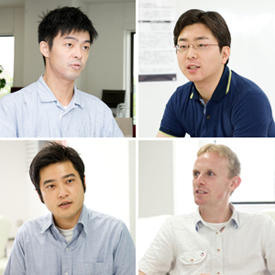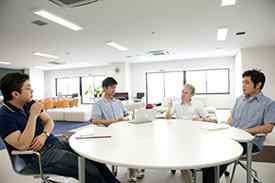

09/30/2013

When the Advanced Institute for Materials Research (AIMR) embarked on its bold strategy of applying a mathematics-driven approach to materials science research under the directorship of Motoko Kotani, it faced a fundamental challenge: how to assist its mathematicians and experimental materials scientists — who respectively contend with abstract concepts and very concrete problems — to speak a common language.
To address this issue, the AIMR created the Interface Unit (IU), a group of eight young theoretical physicists and chemists charged to act as a bridge between the institute’s mathematicians and researchers from three Target Projects — Non-equilibrium Materials, Topological Functional Materials and Multi-scale Hierarchical Materials — chosen as test beds for the mathematics-driven fusion research approach. In addition to carrying out independent original research, members of the IU work closely with their materials science colleagues to develop mathematical tools and models for theoretical aspects of the Target Projects, which subsequently guide the direction of experimental research. The radical approach is not only influencing the way that AIMR scientists tackle their work but also has the potential to break the mold of interdisciplinary research.
Miki Kobayashi, an assistant professor at the AIMR who specializes in non-linear dynamics, joined the IU in 2012. He admits to having had concerns at the outset about the viability of the mathematics-driven research strategy, which were ultimately unfounded. “Materials science is a well-defined field that has achieved remarkable results without any special involvement from the mathematical community, so I wondered if these researchers actually needed our help at all,” says Kobayashi. “But I have been impressed by how receptive my experimental research colleagues are to using mathematics to explore new avenues in materials research,” he adds. Masamichi Miyama, a research associate in theoretical physics, also joined the IU in 2012 and echoes this sentiment. “When I started at the AIMR, I had my doubts about whether my background in statistical thermodynamics would be useful,” Miyama says. “But my experimentalist colleagues have welcomed our involvement, and I think we work really well together,” he adds.
An important tactic used by the IU to build connections between the AIMR’s mathematics and materials research groups has been to identify problems of interest to experimentalists that also have a mathematical ‘hook’. “It’s like a seed for creating discussion from both sides,” says Daniel Packwood, an assistant professor and theoretical chemist who originally hails from New Zealand. “Normally, experimentalists come to me with a problem then we discuss it further and I’ll go away and work on it — and that may lead to publishable research.” This exchange of ideas can work both ways, however, as the theoreticians often come up with mathematical concepts that may be of interest to the institute’s experimentalists.

Free discussion and collaboration are encouraged at the AIMR and channels for interaction include weekly Tea Time sessions. In addition, there are regular informal seminars aimed at stimulating open-ended discussion where participants are encouraged to ask questions, no matter how basic they may seem. “When I arrived at the AIMR, I was wary of approaching colleagues who were experts in areas I knew very little about,” comments Koji Sato, a spintronics researcher who joined the IU in early 2013. “At my previous institution, it would have been difficult for me to do this. But here, we are under pressure — in a positive way — to collaborate, so I made up my mind to not feel intimidated and to ask a lot of questions.”
Allowing members of the IU and experimental researchers to interact without boundaries has greatly improved communication within the AIMR, although there is still a need for a degree of ‘bilingualism’ on the part of IU members. “I do find myself needing to use different language depending on whether I am talking to a mathematician or an experimental researcher,” admits Packwood. A certain degree of individuality is inevitable — and even desirable — according to Kobayashi. “We’re not trying to amalgamate maths and materials science. Our job is to provide a bridge between the two.” Miyama agrees: “I would like mathematicians to retain their individual identity but benefit from the different insight that working with materials scientists can bring.” Consequently, early concern about the viability of the mathematics-driven approach has largely been alleviated, and the institute is now harvesting the first fruits of this strategy — in the form of a number of international conference presentations made by researchers from the IU and papers jointly published with AIMR experimentalists in leading journals.
The IU’s role in promoting efficient fusion research at the AIMR could also serve as a model for other universities and institutes — in Japan and around the world — who are seeking to boost their interdisciplinary research programs. “Given time, the AIMR could provide a template for creating truly functioning interdisciplinary research,” says Packwood. “We’re already producing innovative results that aren’t normally seen in the theoretical physics arena — but not yet in the mathematical arena because the results are so physical in character. Nonetheless, you can’t just mix people together and expect them to do interdisciplinary research. You need a catalyst.” And while the IU provides exactly such a stimulus, it is also helping to create a new approach to research — one that is more predictive and theory led than typical materials science, yet more descriptive than traditional mathematics. “It’s important to be able to discover new things and develop new methods, especially in a mature field like materials science,” notes Sato. “Hopefully our approach will help to unlock new potential, although it won’t be easy.”
Change is unlikely to come overnight and requires experimentalists and theoreticians alike to work outside their comfort zones, with the former accepting a more structured approach to carrying out experiments and the latter being willing to relinquish a degree of theoretical completeness. Although the potential rewards for the AIMR and any resulting interdisciplinary research are great, pushing forward with AIMR director Kotani’s vision for mathematics-driven research will take commitment, hard work and more than a little courage. “The experimentalists are changing the way they do research,” observes Packwood, “and as theoreticians, so must we. It’s exciting, but it’s challenging. We have to learn to think differently; maybe entirely new types of approximation are needed.”